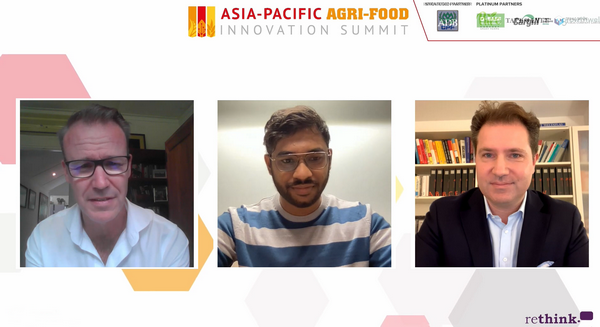"There’s a lot of interest out there from investors: they're just waiting for an improved business model of vertical farms. In return, they can employ larger amounts of funds, not only venture capital but also private equity and infrastructure capital," said Henner Schwarz (Kalera) during an Asia-Pacific Agri-Food Innovation Summit 2021 panel.
Joining him on the panel were conversation leader John Baker, Principal at Equilibrium, Vihari Kanukollu, Co-founder and CEO of UrbanKisaan, a vertical farming company based in India, and Henner Schwarz, Managing director of Middle East, Africa, and Asia at Kalera, a US vertical farming company.
Henner continued, "The industry is still in its infancy and very infrastructure-heavy as of yet. We've been focusing on microeconomics to show investors that we can get there: the more stable production becomes and the better-known the product becomes, the more large investments will follow eventually."
Potential for CEA market
John asked what the current investment state of the CEA market is and how that reflects the opportunities ahead. Vihari explained that indoor farming in India is still at an infant stage. However, the government is giving out subsidies to promote indoor farming, which led to 50.000 acres of CEA cultivation thus far. "The potential is huge here, given 22% of the population is based in farming. As we have a huge population, the agricultural revolution is about to start in India. It's the perfect stage for funding to come in at this point."

From left to right, John Baker (Equilibrium), Vihari Kanukollu (UrbanKisaan), and Henner Schwarz (Kalera)
Potential of CEA market
"Indoor farmers have to bring a different product value. There are many features and values indoor farming products have that are superior to the competitions' produce," Henner noted. At Kalera, it is all about producing an affordable product in order to address a larger premium market, like the organic market. "We have to make sure that our efficient farming system can be at a reasonable price point."
Vihari explained that there is a lot of potential for the Indian fresh produce market given its worth. "We're trying to build a brand around our products. Given the low produce quality in India, hydroponic produce makes a statement in terms of taste, consistency, and quality. People are willing to pay more for this kind of produce." On the other hand, Indians spend about $6 per week to $30-50 per month on fresh produce. It is all about finding a balance.
The future of agriculture - What is it going to take to unlock capital to grow businesses?
Vihari stated that "launching million-dollar farms isn't really possible, given the high ROI and the fact that our market is too limited for that. We can only scale if we're bringing down the CapEx to such an extent that you can grow a larger variety of crops, being able to offer a larger basket."
UrbanKisaan is working on the cost-effectiveness of vertical farms. According to Vihari, the amount of capital that goes into vertical farms is related to how much capital you can raise. "If you cannot make a difference with 1000 acres, you will never really make an impact given the limitations of heavy CapEx. Therefore, UrbanKisaan is bringing down the elements of capital going into farms and operating at the bare minimum. Then we can scale much faster throughout the country."
Henner added that "investors want to know what they get in return, and for us, it's CapEx per m2 of growing space. The larger our farms become, the more efficient we can work. These unit economics are really keen to attract investors. Growers have to understand there are different types of capital out there."
Being able to structure solutions that cater to different investors for very particular situations will help: there are some wealth funds that have a political agenda, or infrastructure money that has a zero-risk appetite, or where you would need an off-take of a joint venture partner that could help you to succeed in the market but also sell out the product. These number of factors have to be addressed in order to become more attractive and help more money get into the industry.
For more information:
Asia-Pacific Agri-Food Innovation Summit
www.agrifoodinnovation.com

For more information:
Kalera
info@kalera.com
www.kalera.com

